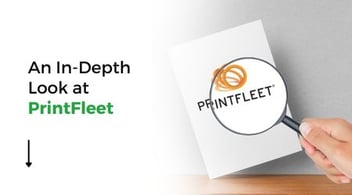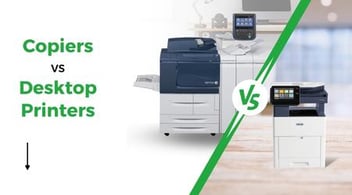Can My Boss See What I Print?

For many employees, printing is a routine office task that they put little thought into. Day in and day out, countless pages are printed throughout the day.
But as online workflow becomes more sophisticated, concerns about privacy and security are also on the rise. Many wonder how their online activities are tracked at work and in their personal lives. Naturally, many employees worry that their printing activities are under surveillance.
Print Partner is the preferred print vendor for hundreds of MSPs throughout the US. With the service suite of our parent company, Green Office Partner, we provide managed print services for the mutual clients of our MSP partners.
This article will tackle the age-old question: Can your boss see what you print?
Print Device Network Capabilities
Before we ask whether or not your boss is monitoring your printing activity, we will address if monitoring is even possible.
What type of devices are you working with?
Most modern copiers can track usage, especially if the device is connected to a company’s dedicated print servers.
Larger companies are likely to work with a managed print provider, which tracks the usage of each printing device, and can even run reports on macro print trends, like times of the day that most people print, days of the week, high-volume print seasons, etc.
Hybrid offices have work-from-home employees who can print in and out of the office and have their print jobs monitored. Today's technology can easily track remote print requests over the Internet.
Following what remote employees print outside the office is essential, as employers want to know if confidential documents are leaked via random printers outside the office.
Smaller companies with older devices that lack Internet connectivity are less likely to monitor print output, or at least to the same meticulous degree as their larger counterparts.
Even if they have an idea of how many print jobs they perform, it is less likely that the employer can check out the specific print jobs.
Overall, print tracking depends on your company's technological capabilities and policies.
It should also be noted that many companies are opting to switch over to alternative ways to run their print network. To learn more, read: Ready for Serverless Printing?
Types of Print Monitoring
When it comes to print monitoring, there are two ways to do so: monitoring print job quantity and monitoring the printed content. We’ll cover each in detail.
Print Usage Monitoring for Budgets
Your employer can first monitor your printing by your general print usage - the numbers don’t lie!
How much are you printing? What times of day are you printing? Are you printing in black and white or in color? Which specific devices in the office are you using?
Tracking print device usage is common practice in offices for financial and budgetary purposes. Knowing how much employees print helps employers plan for the future, setting aside enough funds to prepare for print expenses down the road.
As a managed print provider, our team at Green Office Partner helps our clients monitor their print to keep their costs down.
Monitoring print trends can shed light on overworked or underutilized devices, which can guide us to replace equipment with a better fit when necessary.
So print responsibly! If your organization finds that you are printing far above the average employee, make sure you can back it up!
It’s one thing if your role in the company requires lots of colorful and plentiful print jobs, more than your colleagues. But if you’re caught printing your 100-page screenplay, that’s another story.
Print Monitoring for Security and Compliance Measures
Beyond the numbers, many employers also closely monitor printed content.
“Yes, most companies have their printers configured through a print server that keeps track of the user and the documents they print,” reads an article from Workplace Round Table. “Even smaller companies have ways to investigate your printer activity without an IT department.”
Print monitoring is usually done for security reasons rather than snooping on employees.
Employers are always at risk of security breaches, and print devices are one of the easiest ways for sensitive information to leak. To learn more about print device security, read: Top 10 Tips for Printer Security
Examining printed content is especially true in industries like finance or healthcare, where confidentiality is critical to keep up with compliance measures. Employers could face legal and financial penalties if print devices are not monitored and secured.
Imagine leaking private medical records through the wrong printer - Yikes.
If a print job violates company policy, HR needs to be able to track where the issues stem from and can do so by simply checking who requested each print job.
If you look online, you’ll find plenty of stories about employees getting busted for printing stupid things. We found one particularly hilarious tale from New Zealand about a man getting busted for stealing a coworker’s sandwich and boasting about it anonymously through the office copier.
HR was able to bust him by checking recent print orders. Oops.
Some industries have reasons to monitor print jobs more diligently than others, but it's best to just ask your employer about company policies. Better to be safe than sorry!
We recommend dusting off your trusty employee handbook and reading up on the dos and don’ts of your company’s printing policy to be absolutely sure what is and is not acceptable.
Protecting Your Privacy at the Workplace
If you are concerned about printing sensitive documents at your workplace, there are some measures you can take to protect yourself from big brother.
One option is to use a personal printer that is not connected to the company network.
Remember: Your employer cannot monitor you if you aren’t connected to the company server.
However, this is only sometimes an option, especially in industries like financial services and healthcare, where strict compliance measures are in place.
Another option is to use encrypted documents or password-protect documents before printing them. This helps ensure that only authorized individuals can access the document's content.
That said, there is no foolproof way to print private documents at work. Consult HR or your supervisor on the right course of action if it's a sensitive work-related document. And if it's a non-work-related document… just print it at home on your personal printer.
Companies should make the level of monitoring clear to employees, as well as specify what is and is not acceptable to print on office hardware.
Print Partner and Secure Print Monitoring
Managing print can be a complex topic, especially when considering the ethics of securely monitoring devices.
For many MSPs, print is a headache you’d rather not deal with - which is why many MSPs choose to work with Print Partner!
Print Partner works with MSPs across the country to deliver top-shelf managed print services to mutual clients across the country. If you want to unload the burden of printing off your MSP’s shoulders, refer your clients to us!
Plus, we’ll pay you! For each deal we close, we’ll pay the person who registers the opportunity at least $500 for the introduction and an additional $250 per $25K in revenue the deal brings us. For the MSP, we’ll pay $1,000 per 11x17 MFP sold, $100 per printer sold, and 5% recurring revenue on the client’s print allotment. And we’ll provide exceptional client service while we’re at it.
If you need a partner you can collaborate with your MSP to tackle even the most complex print environments, consider partnering with us, a Print Partner you can trust.



